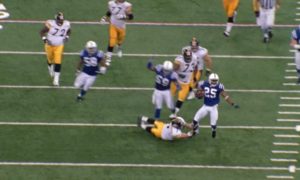The Pittsburgh Steelers made it official yesterday by signing former Oakland Raiders and Indianapolis Colts wide receiver Darrius Heyward-Bey in a move surely aimed toward replenishing the depth and patching holes caused by free agency departures ahead of the draft in May.
The contract was a one-year deal, most certainly for the veteran-minimum value for a vested veteran of his tenure, though I’m not certain if there was a small signing bonus attached to the deal.
Clearly, he’s come a long way—in the wrong direction—even since last offseason, when the Colts gave him a $3 million contract with $1.5 million guaranteed. He was virtually benched by the end of the season.
Still, the Steelers’ move offers little risk—close to none financially—and the potential rewards are certainly greater than the potential harm, the key word being potential.
That doesn’t make the signing any more inspiring, however, and there’s no telling that he even beats out Justin Brown or Derek Moye for a roster spot when all is said and done this summer.
As we have previously shown, he had trouble even holding on to the ball this past season, but what should be emphasized is that last year was by no means an anomaly—or even an extreme outlier.
Heyward-Bey is a five-year veteran, yet the inability to hold on to passes has been a consistent theme throughout his career. In only one of his five professional seasons did he have a drop rate of less than 10 percent. Three out of the five years had a drop rate of greater than 20 percent, including last season, as seen in the chart below.
| Year | Targets | Catchable | Receptions | Com. % | Target % | % Dif. | Drops | Drop % |
|---|---|---|---|---|---|---|---|---|
| 2013 | 58 | 38 | 29 | 50 | 65.52 | 15.52 | 9 | 23.68 |
| 2012 | 77 | 47 | 41 | 53.2 | 61.04 | 7.84 | 6 | 12.77 |
| 2011 | 106 | 70 | 64 | 60.4 | 66.04 | 5.64 | 6 | 8.57 |
| 2010 | 60 | 33 | 26 | 43.3 | 55 | 11.7 | 7 | 21.21 |
| 2009 | 38 | 14 | 9 | 23.7 | 36.84 | 13.14 | 5 | 35.71 |
| Total | 339 | 202 | 169 | 49.85 | 59.59 | 9.73 | 33 | 16.34 |
The chart also contains a lot of other relevant information that helps account for the quarterback targeting him, which, playing most of his career for the Raiders, has not always been advantageous.
Among those details is the fact the career differential between his completion percentage and his target accuracy is nearly 10 percent. Target accuracy is the percentage of passes thrown his way that were on target and should have been caught, which is reached by combining receptions and drops.
Last season reflected the greatest differential in his career between completion percentage and target accuracy with a discrepancy of greater than 15 percent. His quarterback last season was Pro Bowl Colts quarterback Andrew Luck.
By far his best season came in 2011, when the bulk of his targets were thrown by Carson Palmer, and to a lesser extent, Jason Campbell.
He recorded by far his highest completion percentage for a season on the back of the highest target accuracy, but more telling was that it was the season reflecting the smallest differential. That year, he caught 64 passes on 106 targets with six drops, for a career-low drop rate of 8.57.
For his career, however, he has dropped 33 of 202 total catchable balls, which translates to a career drop percentage of 16.34.
In layman’s terms, he has dropped about one in every six passes that he should have caught. This is not an outlier. This reflects who he has been as a player throughout his career, and there’s no easy fix.







